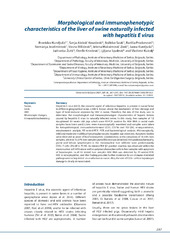Приказ основних података о документу
Morphological and immunophenotypic characteristics of the liver of swine naturally infected with hepatitis E virus
| dc.creator | Kureljušić, Branislav | |
| dc.creator | Aleksić-Kovačević, Sanja | |
| dc.creator | Savić, Božidar | |
| dc.creator | Prodanović, Radiša | |
| dc.creator | Jezdimirović, Nemanja | |
| dc.creator | Milićević, Vesna | |
| dc.creator | Maksimović Zorić, Jelena | |
| dc.creator | Kureljušić, Jasna | |
| dc.creator | Žutić, Jadranka | |
| dc.creator | Knežević, Đorđe | |
| dc.creator | Spalević, Ljiljana | |
| dc.creator | Kukolj, Vladimir | |
| dc.date.accessioned | 2023-03-26T12:05:24Z | |
| dc.date.available | 2023-03-26T12:05:24Z | |
| dc.date.issued | 2021 | |
| dc.identifier.issn | 0505-401X | |
| dc.identifier.uri | https://vet-erinar.vet.bg.ac.rs/handle/123456789/2784 | |
| dc.description.abstract | Hepatitis E virus (HEV), the zoonotic agent of infectious hepatitis, is present in swine farms in different geographical areas. Little is known about the mechanism of liver damage and type of local immune response by HEV in swine. Therefore, the aim of this study was to determine the morphological and immunophenotypic characteristics of hepatic lesions caused by hepatitis E virus in naturally infected swine. In this study, liver samples of 12 slaughtered 10 weeks old pigs which were RT‑PCR positive for HEV RNA in rectal swab samples have been used. Livers were macroscopically examined and samples were taken for histopathological, immunohistochemical (CD3, CD79α and TGF‑β1), semiquantitative, morphometric analysis, RT‑nested‑PCR, PCR and bacteriological analysis. Microscopically, mild and moderate multifocal lymphoplasmacytic hepatitis was observed. Apoptotic bodies were observed as areas of focal eosinophilic condensation in the cytoplasm of 33.33% liver samples, while in 16.67% liver samples portal fibrosis was detected. Immunohistochemically, portal and lobular lymphocytes in the mononuclear liver infiltrate were predominantly CD3+ T cells (234.80 ± 79.98). An intense TGF‑β1 positive reaction was observed within the mononuclear cell infiltrate as well as polymorphonuclear cells in liver samples with apoptosis of hepatocytes. In all 12 tested liver samples HEV RNA was detected by RT‑nested‑PCR. HEV is noncytopathic, and this finding provides further evidence for an immune mediated pathogenesis in hepatitis E virus infection in swine. Also, the role of CD3+ cells in hepatocyte damage is clearly demonstrated. | sr |
| dc.language.iso | en | sr |
| dc.publisher | Istituto Zooprofilattico Sperimentale dell’Abruzzo e del Molise ‘G. Caporale’ (Istituto Zooprofilattico Sperimentale dell'Abruzzo e del Molise) | sr |
| dc.relation | info:eu-repo/grantAgreement/MESTD/Integrated and Interdisciplinary Research (IIR or III)/46009/RS// | sr |
| dc.rights | openAccess | sr |
| dc.rights.uri | https://creativecommons.org/licenses/by-nc/4.0/ | |
| dc.source | Veterinaria Italiana | sr |
| dc.subject | Swine | sr |
| dc.subject | Liver | sr |
| dc.subject | HEV | sr |
| dc.subject | Microscopic changes | sr |
| dc.subject | Immunohistochemistry | sr |
| dc.title | Morphological and immunophenotypic characteristics of the liver of swine naturally infected with hepatitis E virus | sr |
| dc.type | article | sr |
| dc.rights.license | BY-NC | sr |
| dc.citation.volume | 54 | |
| dc.citation.issue | 7 | |
| dc.citation.spage | 287 | |
| dc.citation.epage | 295 | |
| dc.identifier.doi | 10.12834/VetIt.1813.9553.3 | |
| dc.identifier.fulltext | http://veterinar.vet.bg.ac.rs/bitstream/id/8159/bitstream_8159.pdf | |
| dc.type.version | publishedVersion | sr |

